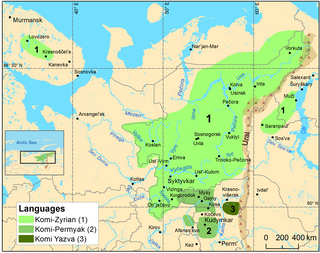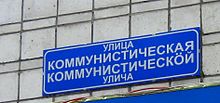

| Komi-Zyrian | |
|---|---|
| коми кыв komi kyv | |
| Native to | Russia |
| Region | Komi Republic, Nenetsia, Permyakia, Yamalia, Yugra, elsewhere in Russia |
Native speakers | 99,609 (2020 census)[1] |
| Cyrillic, Old Permic (formerly) | |
| Official status | |
Official language in | |
| Language codes | |
| ISO 639-3 | kpv |
| Glottolog | komi1268 |

| |

Komi is classified as Definitely Endangered by the UNESCO Atlas of the World's Languages in Danger (2010) | |
| This article contains IPA phonetic symbols. Without proper rendering support, you may see question marks, boxes, or other symbols instead of Unicode characters. For an introductory guide on IPA symbols, see Help:IPA. | |
Komi (коми кыв, komi kyv; Old Permic script: 𐍚𐍞𐍜𐍙 𐍚𐍯𐍮), also known as Zyran, ZyrianorKomi-Zyryan (зыран коми кыв, 𐍗𐍯𐍛𐍐𐍝 𐍚𐍞𐍜𐍙 𐍚𐍯𐍮, zyran komi kyv),[4] is one of the two regional varieties of the pluricentric Komi language, the other regional variety being Permyak.
Komi is natively spoken by the Komi peoples native to the Komi Republic and other parts of Russia such as Nenetsia and Yamalia. There were 285,000 speakers in 1994, which decreased to 160,000 in 2010. Komi has a standardized form.[citation needed]
It was written in the Old Permic script (Komi: 𐍐𐍝𐍑𐍣𐍠, Анбур, Anbur) created by Stephen of Perm for liturgical purposes in the 14th century, though very few texts exist in this script. The Cyrillic script was introduced by Russian missionaries in the 17th century, replacing it. A tradition of secular works of literature in the modern form of the language dates back to the 19th century.
Komi has ten dialects: Syktyvkardin (Sysola), Lower Ežva (Vychegda), Central Ežva (Vychegda), Upper Ežva (Vychegda), Luz-let, Upper Sysola, Pećöra, Iźva, Vym, and Udora dialects. Syktyvkardin is spoken in the region of Syktyvkar and forms the model for the generic standard dialect of the language. Dialects are divided based primarily on their use of /v/ and /l/:[5]
The start of the change date to the 17th century. It is not seen in the oldest Komi texts from the 14th century, nor in loanwords from Komi to Khanty, dated to the 16th; though it fully occurred before Russian loanwords that entered the language in the 18th century as /l/ remains unchanged in these.
Some dialects are further distinguished based on the palatalized alveolars /dʲ tʲ/, which have unpacked in syllable-final position as clusters /jd jt/.[5]


The Old Permic script is the first writing system for Komi. It was invented in the 14th century by the missionary Stepan Khrap. The alphabet resembled medieval Greek and Cyrillic. The script was also known as Anbur (Komi: 𐍐𐍝𐍑𐍣𐍠, Анбур), named for the first 2 letters of the script, "an" & "bur" (𐍐 & 𐍑, respectively). It is no longer in use today, though it has received Unicode Support as "Old Permic" in recent times.[6] The script saw use in Komi-inhabited areas, primarily the Principality of Great Perm and parts of Bjarmaland.
In the 16th century, this alphabet was replaced by the Russian alphabet with certain modifications for affricates. In the 1920s, the language was written in the Molodtsov alphabet, which also derived from Cyrillic. In the 1930s, during the Latinisation in the Soviet Union, Komi was briefly written with a version of the Latin script. Since the 1940s it uses the Russian-based Cyrillic alphabet with the additional letters І, і and Ӧ, ӧ.
| Anbur | Cyrillic | Cyrillic (Molodtsov) | Latin | IPA | Letter name | Notes |
|---|---|---|---|---|---|---|
| 𐍐 | А а | A a | /a/ | а | ||
| 𐍑 | Б б | B b | /b/ | бе | ||
| 𐍮 | В в | V v | /v/ | ве | ||
| 𐍒 | Г г | G g | /g/ | ге | ||
| 𐍓 | Д д | Ԁ ԁ
Ԃ ԃ |
D d Ď ď |
/d/ /ɟ/ before е, ё, и, ю, я, ь |
дэ | |
| 𐍖 | Дж дж | Җ җ | Dž dž | /dʒ/ | дже | |
| 𐍘 | Дз дз | Ԇ ԇ | Dź dź | /dʑ/ | дзе | |
| - | Е е | - | Je je E e |
/e/ [je] word-initially and after vowels /e/ after /c, ɟ, ɕ, ʑ, ɲ, ʎ/ |
е | |
| - | Ё ё | - | Jo jo
O o |
[jo] word-initially and after vowels /o/ after /c, ɟ, ɕ, ʑ, ɲ, ʎ/ |
ё | |
| 𐍕 | Ж ж | Ž ž | /ʒ/ | же | ||
| 𐍗 | З з | З з
Ԅ ԅ |
Z z Ź ź |
/z/ /ʑ/ before е, ё, и, ю, я, ь |
зэ | |
| 𐍙 | И и | - | I i | /i/ /i/ after /c, ɟ, ɕ, ʑ, ɲ, ʎ/ |
небыд и ("soft i") | |
| 𐍙 | І і | I i | /i/ after /t, d, s, z, n, l/ | чорыд и ("hard i") | Non-palatalizing form of и. | |
| 𐍙 | Й й | Ј ј | J j | /j/ | дженьыд и | |
| 𐍚 | К к | K k | /k/ | ка | ||
| 𐍛 | Л л | Л л
Ԉ ԉ |
L l Ľ ľ |
/ɫ/ /ʎ/ before е, ё, и, ю, я, ь |
эл | |
| 𐍜 | М м | M m | /m/ | эм | ||
| 𐍝 | Н н | Н н
Ԋ ԋ |
N n Ń ń |
/n/ /ɲ/ before е, ё, и, ю, я, ь |
эн | |
| 𐍩 | О о
- |
O o
- |
/o/
/ɔ/ |
о
"open o" |
Open "o" is absent in the literary Komi language. | |
| 𐍞 | Ӧ ӧ | Ö ö | /ɘ/ | ӧ | ||
| 𐍟 | П п | P p | /p/ | пе | ||
| 𐍠 | Р р | R r | /r/ | эр | ||
| 𐍡 | С с | С с
Ԍ ԍ |
S s Ś ś |
/s/ /ɕ/ before е, ё, и, ю, я, ь |
эс | |
| 𐍢 | Т т | Т т
Ԏ ԏ |
T t Ť ť |
/t/ /c/ before е, ё, и, ю, я, ь |
тэ | |
| 𐍤 | Тш тш | Щ щ | Č č | /tʃ/ | тше | |
| 𐍣 | У у | U u | /u/ | у | ||
| 𐍫 | Ф ф | - | F f | /f/ | эф | In loanwords. |
| 𐍬 | Х х | - | H h | /x/ | ха | In loanwords. |
| 𐍭 | Ц ц | - | C c | /ts/ | це | In loanwords. |
| - | Ч ч | Ć ć | /tɕ/ | че | ||
| 𐍥 | Ш ш | Š š | /ʃ/ | ша | ||
| 𐍦 | Щ щ | - | Šč šč | /ʃtʃ~ʃː/ | ща | In loanwords. |
| 𐍯 | Ъ ъ | - | - | - | чорыд пас ("hard sign") | Same usage as Russian. |
| 𐍨 | Ы ы | Y y | /ɨ/ | ы | ||
| 𐍰 | Ь ь | - | - | /ʲ/ | небыд пас ("soft sign") | Same usage as Russian. |
| -
𐍔 |
Э э
- |
Ее | E e
- |
/e/
/ɛ/ |
э
"open e" |
Non-palatalizing form of "е".
Open "e" is absent in the modern Komi language. |
| 𐍳 | Ю ю | - | Ju ju
U u |
[ju] /u/ after /c, ɟ, ɕ, ʑ, ɲ, ʎ/ |
ю | |
| 𐍴, 𐍵 | Я я | - | Ja ja
A a |
[ja] /a/ after /c, ɟ, ɕ, ʑ, ɲ, ʎ/ |
я | |
Letters particular to the Molodtsov alphabet include ԁ, ԃ, ԅ, ԇ, ԉ, ԋ, ԍ, ԏ, most of which represent palatalized consonants.
| А а | Б б | В в | Г г | Ԁ ԁ | Ԃ ԃ | Е е | Ж ж | Җ җ | З з | Ԅ ԅ | Ԇ ԇ | |
| І і | Ј ј | К к | Л л | Ԉ ԉ | М м | Н н | Ԋ ԋ | О о | Ӧ ӧ | П п | Р р | |
| С с | Ԍ ԍ | Т т | Ԏ ԏ | У у | Ф ф | Х х | Ц ц | Ч ч | Ш ш | Щ щ | Ы ы |
| Labial | Dental | Post- alveolar |
Palatal | Velar | ||
|---|---|---|---|---|---|---|
| Nasal | m | n | ɲ | |||
| Plosive | voiceless | p | t | c | k | |
| voiced | b | d | ɟ | ɡ | ||
| Affricate | voiceless | t͡ʃ | t͡ɕ | |||
| voiced | d͡ʒ | d͡ʑ | ||||
| Fricative | voiceless | s | ʃ | ɕ | ||
| voiced | v | z | ʒ | ʑ | ||
| Trill | r | |||||
| Approximant | lateral | l | ʎ | |||
| central | j | |||||
| Front | Central | Back | |
|---|---|---|---|
| Close | i | ɨ | u |
| Mid | e | ə | o |
| Open | a |
There are no diphthongs, although vowel sequences can occur at morpheme boundaries.
The phoneme /ɨ/ is phonetically [ɯ̈], and /a/ is phonetically [ä]. There is noticeable positional allophony, depending on the surrounding consonants, however no allophone overlaps with another vowel phoneme.[8]
Komi has 17 cases, with a rich inventory of locative cases. Like other Uralic languages, Komi has no gender. Verbs agree with subjects in person and number (sg/pl). Negation is expressed with an auxiliary verb, which is inflected for person, number and tense.
Komi is an agglutinative language and adheres to a subject–object–verb order.[9] Most modern texts, however, possess a subject-verb-object word order, due to heavy Russian language influence and the resulting calques.
The following sample text displays the Anbur, Cyrillic (modern) and Latin lyrical text from the Komi-Zyryan folk song『Kačaśinjas』(Daisies).
The first verse of the song and the refrain, as written in the Anbur Script:
The second verse and refrain, as written in the Zyryan Cyrillic Alphabet:
The third and final verse and refrain, as written in the modern Latin Alphabet: [citation needed]
|
| |||||
|---|---|---|---|---|---|
| Finnic |
| ||||
| Sámi |
| ||||
| Mordvinic |
| ||||
| Mari |
| ||||
| Permic |
| ||||
| Ugric |
| ||||
| Samoyedic |
| ||||
| Others |
| ||||
| Reconstructed |
| ||||
| |||||
|
| |
|---|---|
| Federal language |
|
| State languages of federal subjects |
|
| Languages with official status |
|
| Scripts |
|
1 In Russia, the Cyrillic alphabet is officially supported. 2 For other, non-Cyrillic alphabets, separate federal laws are required. | |